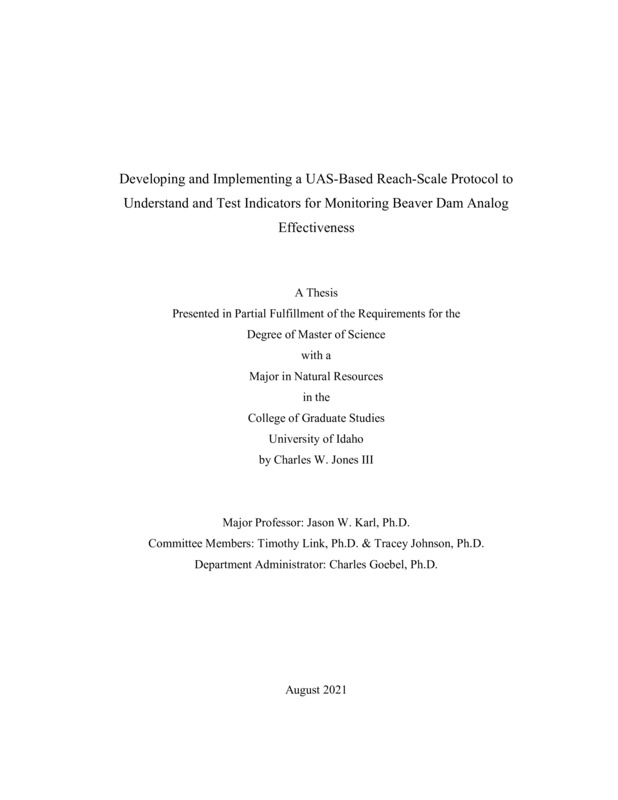Developing and Implementing a UAS-Based Reach-Scale Protocol to Understand and Test Indicators for Monitoring Beaver Dam Analog Effectiveness
Jones, Charles W. (2021-08). Developing and Implementing a UAS-Based Reach-Scale Protocol to Understand and Test Indicators for Monitoring Beaver Dam Analog Effectiveness. Theses and Dissertations Collection, University of Idaho Library Digital Collections. https://www.lib.uidaho.edu/digital/etd/items/jones_idaho_0089n_12031.html
- Title:
- Developing and Implementing a UAS-Based Reach-Scale Protocol to Understand and Test Indicators for Monitoring Beaver Dam Analog Effectiveness
- Author:
- Jones, Charles W
- Date:
- 2021-08
- Program:
- Natural Resources
- Subject Category:
- Natural resource management
- Abstract:
-
Beaver Dam Analogs (BDAs) and other Beaver-Related Restoration (BRR) techniques have increased in use across the western US in response to losses in ecosystem function related to degraded stream systems, head-cuts, entrenched channels, and floodplain and riparian disconnectedness. In hopes of restoring riverscapes and riparian areas and the ecosystem services they provide, managers have implemented these techniques with limited research concerning their effectiveness. Monitoring the effectiveness and the long-term ecological impacts of restoration activities such as BDAs is required to inform managers if objectives have been met and to guide maintenance to ensure effective restoration. I developed and implemented a quantitative monitoring approach that focuses on indicators representing key riparian and stream processes related to reach-scale riverscape changes including: channel length, flow, gradient, BDA structure density, and proportions of riparian vegetation groups, surface water types, and potential riparian/stream area within the valley bottom. Spanning three different ecosystems, I used unmanned aerial systems (UAS) along with in-field measurements to implement the procedure across 31 stream reaches from six BDA projects in Idaho. Univariate and multivariate analyses highlighted possible short-term indicators of treatment effectiveness and the need for more research regarding broader, longer-term impacts. This work supports common short-term expectations such as an increase in percent channel length that is wetted following BDA installation. With a quantitative monitoring approach, effects of riparian and stream restoration can be documented, providing detailed descriptions of the effectiveness of these treatments on different systems and specific functions that managers hope to restore.
- Description:
- masters, M.S., Natural Resources -- University of Idaho - College of Graduate Studies, 2021-08
- Major Professor:
- Karl, Jason W
- Committee:
- Link, Timothy; Johnson, Tracey
- Defense Date:
- 2021-08
- Identifier:
- Jones_idaho_0089N_12031
- Type:
- Text
- Format Original:
- Format:
- application/pdf
- Rights:
- In Copyright - Educational Use Permitted. For more information, please contact University of Idaho Library Special Collections and Archives Department at libspec@uidaho.edu.
- Standardized Rights:
- http://rightsstatements.org/vocab/InC-EDU/1.0/

